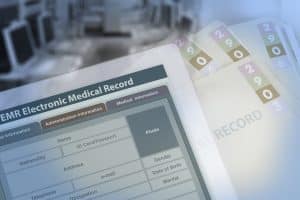While a medical record audit is a lengthy process, it’s a necessary one to ensure your practice is as efficient, organized, and profitable as possible. Clinical documentation in medical records is crucial to delivering the most accurate care to patients, and disorganized medical records can easily hinder this. With medical record auditing, your holistic practice can determine areas that need attention before they result in fraudulent claims and billing activities.
Although medical records audits are necessary preventative measures for both conventional and holistic medical practices, they can be complex and time-consuming. Follow this guide for tips about how to have a thorough and efficient medical record audit to help your holistic practice be as successful as possible.
What is a Medical Record Audit?
Just like any conventional audit, a medical record audit is a process that includes internal or external reviews of what processes are being conducted accurately and what needs to be improved. This includes reviews of medical billing and coding accuracy, procedures, policies, and any other components that affect the efficiency and effectiveness of detailed documentation in your practice.
Medical record auditing is a preventative measure to catch potential errors that can result in liabilities and investigations. For example, these reviews can catch overlooked compliance issues that could impact your bottom line, your practice’s reputation, and the level of care you deliver to patients.
Why is Auditing Medical Records Important For Your Medical Practice?
The benefits of conducting medical record audits are numerous and should be reviewed regularly as a preventative measure at least once a year. Besides checking for compliance and liability errors, a medical record audit can also catch inefficiencies that are costing your holistic practice money.
According to the AACP, some of the benefits of medical record auditing include:
- To determine outliers before large payers find them in their claims software and request an internal audit be done.
- To protect against fraudulent claims and billing activities.
- To reveal whether there is a variation from national averages due to inappropriate coding, insufficient documentation, or lost revenue.
- To help identify and correct problems before insurance or government payers challenge inappropriate coding and conduct governmental investigations.
- To remedy undercoding and code overuse and to bill appropriately for documented procedures.
- To identify reimbursement deficiencies and opportunities for appropriate reimbursement.
- To stop the use of outdated or incorrect codes for procedures.
Auditing is especially important to catch mistakes that may otherwise go undetected and impact your bottom line. A medical records audit can also protect your holistic practice against fraudulent claims and compliance issues. If your practice is consistently submitting inaccurate coding, it could result in lengthy reimbursement delays, investigations, and penalties that cost you both money and time.
Four Tips for a Auditing Medical Records Successfully

When deciding to audit medical records in your holistic practice, the process can be intimidating due to its complexity and lengthy documentation. However, there are some tips you can implement to help speed up the process so you can achieve both an accurate and efficient medical record audit experience! Here are four simple tips to follow for a more successful medical record audit in your holistic practice:
1. Develop a Formal Medical Record Audit Plan
Auditing medical records doesn’t need to be overwhelming if you create an audit plan to streamline the process. Circulating a formal audit plan allows whoever is conducting the audit - whether an internal team or an outside consultant - to have the right communication tools and tactics for an effective audit. This includes developing a medical audit strategy. A popular approach is selecting several charts per provider and per payer and reviewing documentation to compare what was filled out. This helps to assess whether claims were processed appropriately or inaccurately coded.
Your medical audit plan should also determine the specific measurement criteria for the review to help guide the process; these factors should help determine whether or not these criteria are met.
2. Determine Which Recordkeeping Tools To Use for Your Medical Record Audit
Your medical record audit plan should also include how your practice will collect and analyze the review’s results. This will determine the type of recordkeeping tools you’ll use. For instance, will you choose to record data electronically? Will you choose a paper-based system? Or, will your audit team decide to use a solution that combines these two? No matter what record-keeping system you choose to use, the review’s results need to be organized in such a way that it allows for evaluating individual records as well as cumulative data from the entire audit.
Remember, how data is recorded will affect the outcome of your analyses so it’s important to be as consistent as possible to receive the most accurate results.
3. Summarize Your Data Results
With the large amount of data being reviewed in medical record auditing, it’s easy for information and results to get unorganized. This can result in mistakes, which ultimately undermines the purpose of an audit. By summarizing data results, you can prevent data from being disorganized, as well as leave out any irrelevant information that can skew results.
These data results can also include what changes can be implemented where there are areas of opportunity to improve on. Part of the purpose of a medical record audit is to identify areas of improvement, so these summaries can help guide decisions.
4. Create a Medical Record Audit Schedule
Medical record auditing should be a regular occurrence. Your practice should be conducting regular medical record audits at least once a year to be most effective and creating a regular schedule can help ensure audits are completed in a timely fashion. By building auditing processing directly into your daily and billing operations, you can make auditing more streamlined. This can include running frequent reports and monitoring net collections for easy data acquisition.
Your Medical Record Audit Checklist
To help your holistic practice stay on top of your review, follow this medical chart audit. This checklist itemizes what you need to review in your ongoing audit of medical records at the point of care.
- Do the patient records have an accurate patient ID?
- Do they contain biographical and/or personal data?
- Is the person(s) providing care identified on each chart entry?
- Are all entries dated?
- Are all entries legible?
- Is the problem list complete?
- Does the patient have any prominent allergies or adverse drug reactions?
- Do the patient records contain appropriate past medical HX?
- Is smoking, alcohol, or substance abuse HX documented?
- Were lab and other tests ordered as appropriate?
- Are the contents of a history and physical examination available?
- Are plans of action/treatment are consistent with diagnosis(es)?
- Were problems from previous visits addressed?
- Is there any documented evidence of appropriate use of consultants?
- Is there any documented evidence of continuity and coordination of care between primary and specialty physicians?
- Are consultant summaries, lab, and imaging study results included to reflect primary care physician review?
- Is there a completed immunization record on file?
- Are all prescriptions and refills noted?
- Is there a med sheet used and appropriately located?
- Is the chronology maintained?
- Is informed consent noted for all procedures and appropriate prescriptions?
- Are there documentation of patient education and follow-up instructions about procedures?
- Is there a history of missed or canceled appointments?
This checklist is an overview of a typical medical record audit and can be tailored for your holistic practice’s unique procedures. As with all audits, answering these questions as specifically and honestly as possible is integral to the audit’s success.
Improve Your Medical Record Audits With Holistic Billing
The effectiveness of auditing medical records depends on how thorough your process is. A holistic practice inexperienced with auditing, or one which doesn’t have the time to spend on the complex process, can easily wind up making mistakes that can cost time and money down the road. An experienced and proactive firm, with the right resources and experience, can manage your medical record auditing so you can have a streamlined operation to spot inaccuracies and inefficiencies before they cause a problem.
At Holistic Billing Services, you can trust our team of experienced experts to understand the unique needs of holistic practices and medical record auditing. Since we work exclusively with holistic healthcare practices like acupuncture, massage therapy, and chiropractors, we are familiar with how accurate and efficient medical record auditing can help your business. For any questions about medical record audits, feel free to contact our team today, and let us know how we can help your holistic practice!





